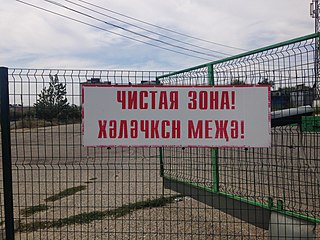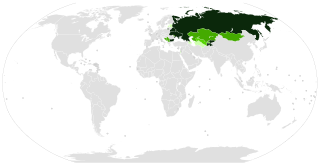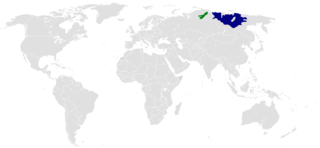
The Cyrillic script, Slavonic script or simply Slavic script is a writing system used for various languages across Eurasia. It is the designated national script in various Slavic, Turkic, Mongolic, Uralic, Caucasian and Iranic-speaking countries in Southeastern Europe, Eastern Europe, the Caucasus, Central Asia, North Asia, and East Asia, and used by many other minority languages.

The Russian alphabet is the script used to write the Russian language. It comes from the Cyrillic script, which was devised in the 9th century for the first Slavic literary language, Old Slavonic. Initially an old variant of the Bulgarian alphabet, it became used in the Kievan Rusʹ since the 10th century to write what would become the modern Russian language.

Kalmyk Oirat, commonly known as the Kalmyk language, is a variety of the Oirat language, natively spoken by the Kalmyk people of Kalmykia, a federal subject of Russia. In Russia, it is the standard form of the Oirat language, which belongs to the Mongolic language family. The Kalmyk people of the Northwest Caspian Sea of Russia claim descent from the Oirats from Eurasia, who have also historically settled in Mongolia and Northwest China. According to UNESCO, the language is "Definitely endangered". According to the Russian census of 2021, there are 110,000 speakers of an ethnic population consisting of 178,000 people.

The Cyrillic I is a letter used in almost all Cyrillic alphabets with the exception of Belarusian.

The Bulgarian Cyrillic alphabet is used to write the Bulgarian language. The Cyrillic alphabet was originally developed in the First Bulgarian Empire during the 9th – 10th century AD at the Preslav Literary School.
Three scripts are currently used for the Tatar language: Arabic, Cyrillic and Latin.

Yeru or Eru, usually called Y in modern Russian or Yery or Ery historically and in modern Church Slavonic, is a letter in the Cyrillic script. It represents the close central unrounded vowel after non-palatalised (hard) consonants in the Belarusian and Russian alphabets, and after any consonant in most of Rusyn standards, where it represents the unrounded close-mid back unrounded vowel sound.

The Ukrainian alphabet is the set of letters used to write Ukrainian, which is the official language of Ukraine. It is one of several national variations of the Cyrillic script. It comes from the Cyrillic script, which was devised in the 9th century for the first Slavic literary language, called Old Slavonic. In the 10th century, it became used in Kievan Rus' to write Old East Slavic, from which the Belarusian, Russian, Rusyn, and Ukrainian alphabets later evolved. The modern Ukrainian alphabet has 33 letters in total: 21 consonants, 1 semivowel, 10 vowels and 1 palatalization sign. Sometimes the apostrophe (') is also included, which has a phonetic meaning and is a mandatory sign in writing, but is not considered as a letter and is not included in the alphabet.
Shor is a critically endangered Turkic language spoken by about 2,800 people in a region called Mountain Shoriya, in the Kemerovo Province in Southwest Siberia, although the entire Shor population in this area is over 12000 people. Presently, not all ethnic Shors speak Shor and the language suffered a decline from the late 1930s to the early 1980s. During this period the Shor language was neither written nor taught in schools. However, since the 1980s and 1990s there has been a Shor language revival. The language is now taught at the Novokuznetsk branch of the Kemerovo State University.

The Tajik language has been written in three alphabets over the course of its history: an adaptation of the Perso-Arabic script, an adaptation of the Latin script and an adaptation of the Cyrillic script. Any script used specifically for Tajik may be referred to as the Tajik alphabet, which is written as алифбои тоҷикӣ in Cyrillic characters, الفبای تاجیکی with Perso-Arabic script and alifboji toçikī in Latin script.
The Russian Latin alphabet is the common name for various variants of writing the Russian language by means of the Latin alphabet.

The Uzbek language has been written in various scripts: Latin, Cyrillic and Arabic. The language traditionally used Arabic script, but the official Uzbek government under the Soviet Union started to use Cyrillic in 1940, which is when widespread literacy campaigns were initiated by the Soviet government across the Union. In Uzbekistan, the Latin script was officially reintroduced, along with Cyrillic, in 1992, and a full transition to Latin script is awaiting implementation. In neighboring Kyrgyzstan and Tajikistan, people use Cyrillic. In the Xinjiang region of China, some Uzbek speakers write using Cyrillic, others with an alphabet based on the Uyghur Arabic alphabet. Uzbeks of Afghanistan also write the language using Arabic script, and the Arabic Uzbek alphabet is taught at some schools in the country.

There are 4 stages in the history of Yakut writing systems:

Numerous Cyrillic alphabets are based on the Cyrillic script. The early Cyrillic alphabet was developed in the 9th century AD and replaced the earlier Glagolitic script developed by the theologians Cyril and Methodius. It is the basis of alphabets used in various languages, past and present, Slavic origin, and non-Slavic languages influenced by Russian. As of 2011, around 252 million people in Eurasia use it as the official alphabet for their national languages. About half of them are in Russia. Cyrillic is one of the most-used writing systems in the world. The creator is Saint Clement of Ohrid from the Preslav literary school in the First Bulgarian Empire.
Transformations of text are strategies to perform geometric transformations on text, particularly in systems that do not natively support transformation, such as HTML, seven-segment displays and plain text.

Yo, Jo or Io is a letter of the Cyrillic script. In Unicode, the letter ⟨Ё⟩ is named CYRILLIC CAPITAL/SMALL LETTER IO.

The Dolgan language is a critically endangered Turkic language with 930 speakers, spoken in the Taymyr Peninsula in Russia. The speakers are known as the Dolgans. The word "Dolgan" means 'tribe living on the middle reaches of the river'. This is most likely signifying the geographical location of the Dolgan tribe. Its closest relative is Sakha.
The Komi language, a Uralic language spoken in the north-eastern part of European Russia, has been written in several different alphabets. Currently, Komi writing uses letters from the Cyrillic script. There have been five distinct stages in the history of Komi writing:
Since its inception in the 18th century and up to the present, it is based on the Cyrillic alphabet to write the Udmurt language. Attempts were also made to use the Latin alphabet to write the Udmurt language. In its modern form, the Udmurt alphabet was approved in 1937.
Khakass alphabets are the alphabets used to write the Khakas language.













